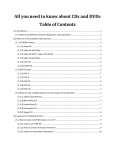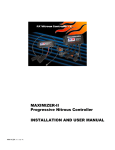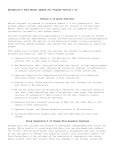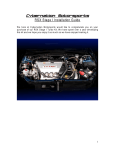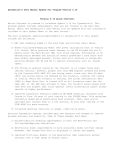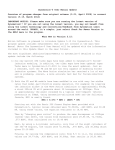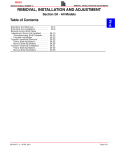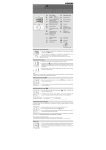Download KWS002x 2-Stage Mini-Progressive manual rev G
Transcript
2-Stage Progressive Mini-Controller & 2-Stage TPS and RPM Window Switch INSTALLATION AND USER MANUAL KWS002x rev G i Table of Contents Page 1. Overview ........................................................................................................................................................................................... 1 2. Software Installation Installation......................................................................................................................................................................... 1 3. Software ............................................................................................................................................................................................ 2 3.1 Entering User Data....................................................................................................................................................................2 3.2 Throttle Position Sensor (TPS) ..................................................................................................................................................3 3.3 RPM ...........................................................................................................................................................................................3 3.4 Stage Set-up ...............................................................................................................................................................................3 3.4.1 Non-Progressive Mode Options .........................................................................................................................................4 3.4.2 Progressive Mode Options .................................................................................................................................................4 3.4.2.1 Time-Based Curve .........................................................................................................................................................4 3.4.2.2 RPM-Based Curve .........................................................................................................................................................4 3.5 4. Upload / Download Configuration ............................................................................................................................................5 Installation Installation......................................................................................................................................................................................... 5 4.1 Wide-Open-Throttle Setup .........................................................................................................................................................6 4.2 RPM Setup Verification .............................................................................................................................................................6 5. Software and Firmware Updates Updates..................................................................................................................................................... 6 6. Disclaimer ......................................................................................................................................................................................... 7 7. Warranty .......................................................................................................................................................................................... 7 8. Wiring Diagram: 2-Stage Controller ............................................................................................................................................. 8 9. Wiring Diagram: 2-Stage TPS and RPM Window Switch Switch............................................................................................................ 9 10. Wiring Diagram: 2-Stage TPS and RPM Window Switch (upgrade) ..................................................................................... 9 11. Wiring Diagram: 2-Stage Progressive Mini-Controller ......................................................................................................... 10 KWS002x rev G 1 1. Overview The 2-STAGE TPS AND RPM WINDOW SWITCH is a digital controller that combines the functions of a throttle position sensing switch and two RPM window switches all into a very compact module. The device also supports low-voltage OEM, V10 or 3 cylinder TACH signals without the need for additional adapters. It works with most OEM throttle position sensors including most drive-by-wire vehicles. The manual trigger input allows the driver to over-ride the controller and disable or enable the stages manually. By adding the optional FJO HIGH CURRENT SOLENOID DRIVER, it can be upgraded to a 2-STAGE PROGRESSIVE MINI-CONTROLLER. The 2-STAGE PROGRESSIVE MINI-CONTROLLER combines the functions of our 2-STAGE TPS AND RPM WINDOW SWITCH and our HIGH CURRENT SOLENOID DRIVER all into one very compact module. It can progressively drive two channels, each with a 40 amp load capacity (continuous duty). The device also supports low-voltage OEM, V10 or 3 cylinder TACH signals without the need for additional adapters. It works with most OEM throttle position sensors including most drive-by-wire vehicles. This device also includes FJO's "real curve" ramp, which allows you to create a progressive curve instead of just a ramp. The ramp can be either time based or RPM based. All this and it’s only the size of a spark plug box. 2. Software Installation If you have the autorun feature enabled on your cdrom drive, wait for the navigation screen and follow the instructions to install the software. If the application does not auto-start, go to the cdrom directory and run “startpgm.exe” Note: For Windows 98SE, the driver files will not be automatically installed. Once you have installed the software and connect the controller, you will be prompted for the location of the driver files by the windows “new hardware wizard”. The files are located in the “C:\Program Files\FJO Racing\2Stage Mini-Controller\USBDriver” subdirectory. KWS002x rev G 2 3. Software The following settings do not require that the controller be connected to the PC until you are ready to UPLOAD. All changes made to the set-up require that you UPLOAD to the controller before installing it in the vehicle. (See Upload/Download section). 3 .1 Entering User Data Drag & Slide – data fields that have this feature have a down arrow button to the right. Clicking and holding the button causes a slider bar to appear. Moving the mouse left or right while the slider is displayed will decrease or increase the value. Increment/Decrement buttons - data fields that have this feature have up/down arrow buttons to the right. Click on either of these to increase or decrease the value accordingly. Menu pull-down – data fields that have this feature have a down arrow button to the right. Clicking on the button will cause a pull-down menu to appear. To select, click on one of the displayed options. Typing – clicking on the data field will highlight the value. You can then use the keyboard to enter the value. DO NOT connect the controller to your PC until you have installed the software. KWS002x rev G 3 3 .2 Throttle Position Sensor (TPS) Throttle Position Sensor (TPS) allows you to select if the output voltage from the throttle position sensor increases (Rises) or decreases (Falls) at wide-open-throttle (WOT). Note: If used with a WOT switch, set to “Rises” and connect the switch as shown in the wiring diagram. WARNING: setting this to the incorrect mode may result in nitrous and fuel being discharged while the throttle plate is closed. Serious engine damage and possible injury can occur as a result. 3 .3 RPM RPM Multiplier selects the correct pulse count for the RPM counter. Use the following as a guide to determine the correct setting: a) Using a TACH signal - TACH signals will typically have 1 pulse per cylinder during 2 revolutions of the crankshaft (1 full cycle) and therefore the correct setting would be ÷(½ the number of cylinders) Example: When using a TACH signal 4 cylinder setting would be ÷2 6 cylinder setting would be ÷3 8 cylinder setting would be ÷4 b) Using a trigger signal from a coil - first determine how often it fires per revolution of the crankshaft. The correct setting would be: x1 for a waste-spark since it fires each revolution of the crankshaft x2 for a full-sequential since it fires every other revolution. This setting must be verified prior to operation. Verifying this setting will require the unit to be installed on the vehicle – see installation instructions later in the manual. 3 .4 Stage Set-up The following applies to both Stage 1 and Stage 2. Present allows you to permanently turn off a stage. A check mark tells the controller to activate the stage as per the configuration. No check mark means this stage is always OFF. Progressive Solenoid Driver Connected sets the mode of the output stages. Blank means that the output is configured to drive a relay. With a checkmark in this box, the controller is configured to drive the FJO SOLENOID DRIVER in progressive mode. DO NOT use the progressive mode unless you have the Progressive Mini-Controller or the optional FJO SOLENOID DRIVER module connected to the Window switch controller. Trigger Switch will setting determines if the trigger switch will enable, disable or have no effect on the applicable stage when the switch is ON ( connected to 12 volts). The trigger switch input can be used to control the output stages manually such as disabling them when the Transmission-brake is engaged, or as a driver over-ride. KWS002x rev G 4 Enable First-Gear Lockout allows you to disable a stage until the first time you pass through the RPM window. RPM Cutoff allows you to set the upper RPM threshold above which the nitrous will be turned off. (useful with locked torque converters) RPM Trigger allows you to set the minimum RPM required before the Nitrous can be triggered. 3.4.1 Non-Progressive Mode Options During the RPM Window … determines if the relay attached to the stage output gets turned ON or OFF when the stage is active. 3.4.2 Progressive Mode Options FJO’s “Real Curve” technology allows you to drag and drop any dot on the ramp between 0-100%. The controller will extrapolate between the dots thus creating a nitrous curve instead of the traditional ramp. We have provided some additional tools to help smooth the overall curve, which we discuss in the following sections. Reset to Straight Line allows you to set the curve to a straight line between the Start and Final targets. (to simulate a simple ramp) Smooth When Dragging when checked will drag multiple dots along with the selected one. It will attempt to soften rapid transitions from one step to the next in an effort to create a curve Smooth Points will apply a smoothing algorithm to your curve. This button can be pressed multiple times until the desired curve is achieved Undo is an undo button. If you applied the smooth points feature or dragged a dot, this feature will undo the change. It has multiple levels so you can undo several changes Solenoid Frequency is the rate at which the controller cycles the solenoids. This number is determined by the solenoid manufacturer. Start sets the start percentage of the stage 3.4.2.1 Time-Based Curve Final sets the final percentage of the stage. The ramp will maintain this level until the RPM cut-off is reached or the stage is deactivated by the TPS or RPM window. Delay sets the time that the controller will delay starting the ramp once a stage has been activated RAMP sets the build time for the ramp 3.4.2.2 RPM-Based Curve Final sets the percentage of the stage at the RPM End target. RPM End sets the upper RPM limit of the curve. Above this RPM, the controller will maintain the final percentage until the RPM Cut-off threshold is reached. KWS002x rev G 5 3 .5 Upload / Download Configuration DO NOT connect the controller to your PC until you have installed the software. To connect the controller to your PC, use the USB cable supplied with the kit. The controller is powered by the USB port on your computer and as such does not require any additional power sources. Plug the USB cable into an available port on your PC. Note: If you are using a USB hub, it must be capable of providing 100mA of current to power the controller. Once the software has identified the FJO 2-STAGE SWITCH, the buttons will become fully visible and the connected ICON will be green. Clicking on the UPLOAD button will store your settings in the controller. The “Config Uploaded” window will appear following a successful upload. You are now ready to install your 2-STAGE Controller on the vehicle. 4. Installation The 2-STAGE Controller is designed to be installed almost anywhere on the vehicle. Select a location that is away from heat sources that can damage the wires. Before permanently installing the device, we recommend that you complete the installation procedure below, as you will need access to the potentiometer and have a clear view of the LEDs for the final steps. Using the wiring diagram applicable to your application, connect the harness as illustrated. Power Input should be connected to the arming switch and fused for 5 amps Controller Ground should be connected to chassis ground as close as possible to the battery and preferably not to the same location that the FJO HIGH CURRENT SOLENOID DRIVER is grounded to. Driver Ground (12 AWG black wire) from the SOLENOID DRIVER must be connected to a good ground location that can handle 80 AMPS. DO NOT connect to the ECU ground connection. While pulsing the solenoids, this will generate large amounts of electrical noise that can interfere with the controller or your ECU. TACH input is designed to work with most Tachometer signals (down to 3 Volts), without the need for a separate adapter. Trigger switch input requires a 12-volt signal to turn it on. TPS signal input is designed to work with most throttle-position-sensors (TPS) and wide-openthrottle (WOT) switches. KWS002x rev G 6 Stage 1 & 2 Control Outputs (Window Switch) are designed to trigger the FJO HIGH CURRENT SOLENOID DRIVER or the ground side of a relay coil. FJO HIGH CURRENT SOLENOID DRIVER is designed to handle a maximum load of 40 amps per stage (continuous duty) 4 .1 1) 2) 3) 4) 5) 6) 7) 8) 4 .2 Wide-Open-Throttle Setup Before connecting the 2-STAGE PROGRESSIVE SWITCH adjust the potentiometer to the initial position by turning it 25 turns clockwise for a rising voltage TPS, or 25 turns counterclockwise for a falling voltage TPS. Disconnect the solenoids from the relays to prevent them from firing. Turn on the ignition power and arm the 2-STAGE PROGRESSIVE SWITCH. Verify that the RED / YELLOW / GREEN LEDs are off with the throttle in the idle position. Push the throttle to the wide-open position (WOT) and hold it. If the GREEN LED is on, adjust the potentiometer to turn it off by turning it clockwise for a rising voltage TPS, or counterclockwise for a falling voltage TPS. Once the GREEN LED goes out proceed to the next step. Now turn the potentiometer the other way until it just comes back on and then one additional turn. Verify that the GREEN LED goes off at IDLE and on at WOT. Repeat steps 4-6 as necessary. RPM Setup Verification 1) 2) 3) 4) 5) Disconnect the solenoids from the relays to prevent them from firing. Turn on the ignition power and start the engine. Arm the 2-STAGE PROGRESSIVE SWITCH. Verify that the RED / YELLOW / GREEN LEDs are off with the throttle in the idle position. Slowly increase the throttle until you reach the Turn On At RPM setting that you downloaded for stage 1. 6) Watch the YELLOW LED. If you set the correct RPM multiplier it will come on just as you reach the target RPM. 7) Now repeat steps 5 and 6 and watch the RED LED and use the Turn On At RPM setting that you downloaded for stage 2. 8) If the LEDs come on at the right RPM, then you selected the correct multiplier. 9) If the LEDs come on too late then the RPM multiplier is too high and you need to set the multiplier to ½ the previous setting and repeat the RPM set-up verification. 10) If the LEDs come on too soon then the RPM multiplier is too low and you need to set the multiplier to 2x the previous setting and repeat the RPM set-up verification. Note: DO NOT use the half-step multipliers unless this is a 3 or 10 cylinder application. The installation is complete! 5. Software and Firmware Updates Free updates are available for the 2-Stage Controller and related software at www.fjoracing.com KWS002x rev G 7 6. Disclaimer FJO Racing Electronics shall not be held responsible for any damages, howsoever caused, to any persons or equipment during the installation or operation of its products. FJO Racing Electronics products are meant for off-road use only, and make no claims as to the unit’s ability to meet local safety or emissions laws. 7. Warranty FJO Enterprises Inc. (FJO) warrants the material and workmanship of the equipment, components and parts manufactured by FJO against defects under normal use and service. This warranty shall extend for 180 days from the date of manufacture provided that the customer first returns the defective part or component through an authorized distributor, shipping costs prepaid. Prior to returning a product for warranty inspection, the customer must contact FJO’s service department with the product serial number to receive a WARRANTY CLAIM NUMBER. Units returned without this number will be refused. FJO may at its option, repair or replace without cost for parts and labour, the defective product. This warranty does not cover finishes, normal wear and tear, nor does it cover damage resulting from accident, misuse, dirt, tampering, unreasonable use, service attempted or performed by unauthorized service agencies, failure to provide reasonable maintenance, or FJO products that have been modified or used for commercial reasons. FJO specifically does not warrant equipment, parts or components purchased by FJO or the customer from any third party manufacturers or suppliers. Rather, for any defect in respect of equipment, parts and components purchased from third party manufacturers and suppliers, the customer shall have recourse only to the terms of the warranty of that particular manufacturer or supplier. Any recommendations made by the third party manufacturer or suppliers concerning the use or application of their products are those of the manufacturer or supplier, and FJO extends no warranty with respect to the results obtained for their use. FJO does not warranty those products in any way beyond the term of the warranty extended by the manufacturer or supplier. The warranty provided above, FJO’s obligations and liabilities hereafter, and the rights and remedies of the customer are exclusive and in substitution for, and the customer waives all other warranties, guarantees, obligations, liabilities, rights and remedies, expressed or implied, arising by law or otherwise, including (without limitation) the implied warranties of merchantability or fitness of purpose, and any obligations or liability of FJO arising from tort, or loss of use, revenue or profit, or for incidental or consequential damage. KWS002x rev G 8 8. Wiring Diagram: 2-Stage Controller 5A Fuse White A White/R ed B C D Power (+12V) Throttle posit ion sensor Red Trigger Switch Input Green R PM E F G Yello w H Stage 1 con trol outp ut Stage 2 con trol outp ut Oran ge J Black K Ground 2-STAGE TPS and RPM WINDOW SWITCH A B C D 5A Fu se White White/Red Power (+12V) Throt tle position sensor Red Trigger Switch Input G reen RPM E F G H J K Bla ck Ground Stage 1 So lenoid grou nd Stage 2 So lenoid grou nd 2-STAGE Progressive Mini-Controller KWS002x rev G 9 9. Wiring Diagram: 2-Stage TPS and RPM Window Switch Arming SW j Power (+12V) 5A Fuse to Throttle-position Sensor Wide-open Throttle SW B C D j White Trigger Switch W hite /Red j A Re d Green j F G J K Yellow Orange Black Nitrous Oxide ` ` H to TACH signal Stage 1 Relay E Fuel j Gr ound Nitrous Oxid e Stage 2 Relay Required if no throttle position sensor is present Fuel Not used when Wide-open throttle switch is used to battery 10. Wiring Diagram: 2-Stage TPS and RPM Window Switch (upgrade) A rming SW j 5A Fuse Power (+12V) to battery to Throttle-position Sens or Wide-ope n Throt tle SW j White Trigge r Swi tc h W hite/Red j Red Green t o TA CH signal Black Ground Fuel Sole no id Stage 2 Nitro us Solenoid Required if no throttle position sensor is present F uel Sol eno id Nitr ous So leno id Not used when Wide-open throttle switch is used KWS002x rev G Stage 1 j j ` ` Yellow O range 10 11. Wiring Diagram: 2-Stage Progressive Mini-Controller A rmi ng SW j 5A Fuse Power (+12V) to battery to Throttle-position Sens or Wide-ope n Throt tle S W j White Trigger Swi tc h W hite/Red j Red Green t o TA CH signal Ground Fuel Sole no id Ground Stage 1 Nitro us Solenoid Required if no throttle position sensor is present F uel Sol eno id Nitr ous So leno id Not used when Wide-open throttle switch is used KWS002x rev G Stage 2 j ` ` j Black












